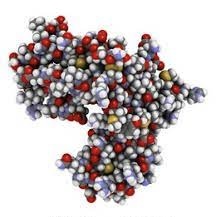
Dr PONS Olivier OMD, NMD, PhD, Professor
Interleukin 6 (IL6) is a cytokine belonging to the trio of pro-inflammatory cytokines of innate immunity, 2,3)
Innate immunity (interleukin-1, interleukin-6 and tumor necrosis factor) in the acute phase of inflammation (this is a pro-inflammatory cytokine). In particular, it stimulates the secretion of acute phase proteins during the innate immune system reaction (APP, or acute phase protein). Its gene is IL6 located on human chromosome 7.4
Ten cytokines of the IL-6 family have been identified: IL-6, oncostatin M (OSM), leukemia inhibitory factor (LIF), ciliary neurotrophic factor (CNTF), cardiotropin-1 (CT-1), cardiotrophine-like cytokine (CLC), neuropoietin (NP), IL-11, IL-27 and IL-31, 5,6,7. All these cytokines share the membrane glycoprotein gp130 as a common receptor and signal transducer subunit in their receptor complexes, with the exception of IL-31.
Interleukin 6 is a key cytokine in the regulation of acute and chronic inflammation and plays a messenger role between the cells involved in this process.
An overproduction of interleukin 6 and its receptor (IL6R) causes inflammation and lesions
Joint diseases associated with rheumatoid arthritis
Physiological functions
IL-6 is a pleotropic cytokine produced in response to tissue damage and infections, 7
Several types of cells, including fibroblasts, keratinocytes, mesanglial cells, endothelial cells, mast cells, macrophages, dendritic cells and T-lymphocyte and B-lymphocyte cells are associated with the production of this cytokine8.
Cell differentiation
Its expression is regulated by NF-IL6 (also called CEBPB)9.
IL-6 is known to have an important role in the differentiation of certain cell types.
Indeed, the binding of IL-6 to its IL6R receptor as well as to the gp130 10 molecule, leads to the activation of the jak 11 protein (janus kinase). Jak then activates the STAT signalling pathway, in particular the STAT 3 protein. The STAT 316s dimerize and thus penetrate into the nucleus by nuclear translocation. The STAT factor 3 then associates with a histone acetyltransferase (HAT), named “CBP”. The HAT are negatively charged and interact with the negatively charged histones in order to decompact the chromatin of a nucleotide sequence of a gene. CBP is the HAT of STAT 3 and when STAT 3 attaches to CBP, CBP induces the decompaction of the chromatin of the sequence encoding the p21 protein. STAT 3 is a transcription factor known to attach (in particular) to the promoter of the p21 gene, which will increase the level of p21 protein in the cell and thus induce a temporary cessation of the cell cycle. This stop is necessary for the establishment of cellular differentiation phenomena, and this is the reason why IL-6 is used by the body in embryogenesis development and the formation of the central nervous system or even in the differentiation of a B lymphositis into a plasma cell, for example. It also plays a role in the genesis of malignant hematopathies, 12.
It also activates the SPH2 pathway and that of phosphoinositide 3-kinase/akt , 13
On immune cells
The biological effects of interleukin-6 are:
* the control of the differentiation of monocytes into macrophages by regulating the expression of the stimulation factor , 14 ;
* the increase in the production of immunoglobulin G of B lymphocyte cells by regulating the expression of interleukin-2115 ;
* the negative regulation of the maturation of dendritic cells by activation of the STAT316 signalling pathway;
* the promotion of the Th2 response by inhibiting the Th1 , 17 polarization.
Two different mechanisms have been described to promote the inhibition of Th1 polarization by IL-6 4,18
* IL-6 stimulates CD4 T cells to secrete IL-4 and direct the response to Th 2 ;
* IL-6 affects the secretion of IFNy by CD4 T cells, an essential interferon to promote Th1 polarization. A similar effect is produced in Th1 cells, where the inhibition of IFNy secretion in these cells affects the activation of CD8 T cells.
In combination with other molecules
In combination with growth factor beta, IL-6 induces the differentiation of naive CD4 into Th17 cells, which are important for the defense against pathogens at the mucosal level.19 ;
• The synergistic interactions of IL-6 with IL-7 and IL-15 induce the differentiation and the cytolytic capacity of CD8 20 T lymphocytes;
* IL-6 is a powerful pyrogenic cytokine and has an essential role in the organization of lymphocyte traffic to the lymphoid organs during febrile event 21.
Iron metabolism and inflammation
IL-6 is thought to be responsible for the sequestration of serum iron in macrophages during inflammation, 22, via the increase in hepcidin expression. This action could play a role in the fight against infection, by limiting the availability of circulating iron and thus harming microbial metabolism.
Role of myokines
Interleukin 6 is also considered to be a myokine, that is to say a cytokine produced in the muscles, with a higher-level during muscle exercise 23.
Involvement in pathology
Suspected role in atheroma
A mutation of its receptor leads to a decrease in its activity, an increase in circulating interleukin 6, a decrease in the level of CRP, a marker of inflammation and a possible marker of cardiovascular risk. It is associated with a decrease in the risk of occurrence of cardiovascular diseases, 24,25,26.
Role in viral infection
Stimulation of the interleukin-6 receptor triggers the initiation of the JAK/STAT3 transcription pathway with the production of cytokine, receptor kinases , 27. The number of genes regulated by IL-6 activity may explain the pleotropic nature of this interleukin. Consequently, the biological consequences of IL-6 production have been associated with pro- and anti-inflammatory effects, highlighting the pivotal role of IL-6 in the activation and regulation of the immune response28.
Interleukin -6 as a therapeutic target
Tociliumab is a monoclonal antibody blocking the interleukin 6 receptor and is used in rheumatoid arthritis. Sirukumab, like oklozumab, attaches itself directly to interleukin 6.
Mindfulness meditation:
Often solicited for its therapeutic virtues related to stress, mindfulness meditation never ceases to fascinate the scientific world. But does this practice actually work? A team of researchers from Carnegie Mellon University in the United States has demonstrated that meditation increases connectivity in the prefrontal cortex and decreases the level of interleukin 6, known as the biomarker of inflammation.
A fundamental step in Buddhism, mindfulness meditation was imported to the United States in the 50s where it found several applications in psychology and behavioural therapy. Touted for its benefits against stress and depression, this practice consists of focusing on the present moment and analysing the sensations felt. How does it work?
To answer this, David Creswell, co-author of the publication, and his team of researchers conducted a study with 35 people looking for a job with a high level of stress. The volunteers were separated into two groups: one part underwent mindfulness meditation training for three days, while the other practiced only classical relaxation. The 35 people were subjected to a brain scan at rest, 5 minutes before and after training. Blood samples were also taken before the program and then four months after.
A brain structural change
Although the cohort seems small in size, the results obtained are interesting. Mindfulness meditation seems to have effects on the structure of the brain. Indeed, the scans carried out in people who have practiced mindfulness meditation reveal an increase in connectivity in the dorsolateral prefrontal cortex. This area is known to be involved in attention and executive functions, which control behavior. The relaxation group does not present these changes.
In addition, blood tests show a reduction in the level of interleukin-6, a biomarker of inflammation, in meditators. These results therefore confirm the role that mindfulness meditation plays in the brain’s ability to reorganize neural networks. “We believe that these changes at the brain level provide a neurobiological marker of better executive control and better resistance to stress, in such a way that mindfulness meditation improves the brain’s ability to help us manage this stress,” believes David Creswell.
Mindfulness meditation therefore seems to do as much good for the body as for the mind. And as the famous violinist and conductor Yehudi Menuhin said, “There is no need to meditate in the name of Jesus, Buddha or anyone else. It is enough to meditate, quite simply.
A study published in 2003 by Richard Davidson and Jon Kabat-Zinn “alterations in brain nd immune function produced by mindfulness meditation” highlighted the link between meditation and immunity;
The study in question consisted of recording the electrical activity of the brain of healthy subjects before and after mindfulness meditation training, which was in the form of an MBSR stress reduction program developed by Jon Kabat-Zinn.
A first electroencephalographic recording was made just before the start of the program – that is to say after eight weeks of mindfulness training
– and a third four months later. The results obtained were unequivocal: compared to the subjects of a control group who had not followed the MBSR training, the individuals who practiced mindfulness displayed a significant increase in the activation of their left prefrontal cortex, at rest and in stressful situations.
This increase was associated with an improvement in overall mood, a decrease in the level of anxiety, a greater ability to remain positive in negative circumstances, an increased ease of finding solutions to conflicts and difficulties, greater dynamism and better commitment to work. And remarkably, all these changes persisted until the end of the study, that is to say four months after the cessation of mindfulness training.
In addition, Davidson and Kabat-Zinn observed, in individuals trained in MBSR, a close correlation between the increase in the activity of the left prefrontal cortex and the increase in the production of antibodies by the immune system. In conclusion, this study shows that mindfulness training increases the body’s defences and plays a regulatory role of primary importance at the level of the psychocorporeal mechanisms involved in the development of diseases and the preservation of good health.
Deconstructing the effects of the practice of concentration meditation on interference control: the roles of controlled attention and inflammatory activity.
Grant S Shields 1, Alea C Skwara 2, Brandon G King 3, Anthony P Zanesco 4, Firdaus S Dhabhar 5, Clifford D Saron 6
Abstract:
Previous work has linked the practice of meditation to improvements in interference control. However, the mechanisms underlying these improvements are relatively unknown. In the context of meditation training, improvements in interference control could result either from increases in controlled attention to objective-relevant stimuli, or from reductions in automatic capture by non-objective-relevant stimuli. In addition, few studies have established a link between training-related changes in attention and physiological processes, such as inflammatory activity, which are believed to influence cognitive function. This study addresses these gaps by examining the associations between cognitive performance and cytokines in the context of an intensive meditation retreat. The participants were randomly assigned to first complete 3 months of meditation training or to serve as witnesses on the waiting list. The participants in the waiting list control then underwent a separate 3-month training intervention. We evaluated the control of participants’ interference with an accompanying task and used computer modeling to derive the component processes of controlled and automatic attention. We also took blood samples at the beginning, middle and end of the training to quantify changes in cytokine activity. Participants who completed the training demonstrated better controlled attention than the waiting list controls during the first retreat intervention, and the controls showed significant improvements in controlled attention when they completed their own second retreat.
It is important to note that inflammatory activity was inversely associated with controlled attention during both interventions. Our results suggest that the practice of concentration meditation influences interference control by improving controlled attention to task elements relevant to the objective, and that inflammatory activity is related to individual differences in controlled attention. J Cogn Neurosci. 2019 August;31(8):1184-1204. doi: 10.1162/jocn_a_01419. Online publication on May 6, 2019.
Modulation of event-related visual discrimination potentials through meditation training and sustained attention
Anthony P Zanesco 1 2, Brandon G King 1, Chivon Powers 1, Rosanna De Meo 1, Kezia Wineberg 1, Katherine A MacLean 1, Clifford D Saron 1
Abstract :
The ability to discriminate the stimuli relevant to the objective tends to decrease when the detections must be carried out continuously over time. Previously, we reported that intensive shamatha meditation training (focused attention) can improve perceptual discrimination of visual stimuli that are difficult to detect [Maclean, KA, Ferrer, E., Aichele, SR, Bridwell, DA, Zanesco, AP, Jacobs, TL, et al. Intensive meditation training improves perceptual discrimination and sustained attention. Psychological Sciences, 21, 829-839, 2010]. Here, we extend these results to examine how discrimination difficulty and meditation training interact to modulate event-related attention and perceptual processing potentials during alertness. The participants in the training and the waiting list performed a continuous performance task at the beginning, middle and end of two 3-month meditation interventions.
In the first intervention (Retreat 1), the objective of the continuous performance task was adjusted through the evaluations to correspond to the training-related changes in the participants’ perceptual ability.
In the second intervention (retreat 2), the target was kept constant throughout the training, regardless of the changes in the ability to discriminate. No training effect was observed during Retreat 1, while Retreat 2 was associated with changes in the appearance of the first sensory signals and an attenuation of intra-task decrementations at the first latencies. In addition, changes at later stages of stimulus processing were directly correlated with improvements in the perception threshold during the second intervention. Overall, these results demonstrate that improvements in perceptual discrimination can modulate the electrophysiological markers of perceptual processing and attentional control during sustained attention, but probably only in conditions where an individual’s ability to discriminate is allowed to exceed the demand imposed by the difficulty of a visual target
Context
These results contribute to the basic understanding of the dependence of perceptual processing and attentional control on contextual requests and their susceptibility to directed mental training.
Mindfulness, or mindfulness, is commonly defined as the state of consciousness that emerges when we voluntarily fix our attention on the lived experience, in the present moment, without judgment. Mindfulness-based meditation represents an integrative technique (“body/mind” action) recognized for its effectiveness in reducing stress as well as depressive and anxiety symptoms30,31. This type of meditation is a legacy of practices, especially Buddhist, but have appeared independently in different cultures and societies over the centuries. Professor Jon Kabat-Zinn, professor of molecular biology at the Massachusetts Institute of Technology, is credited with pioneering the contribution of this practice in the medical sciences.
In the 1990s, he developed a standardized and secularized meditation program based on mindfulness: the Mindfulness-Based Stress Reduction (MBSR) 32 program. Anchored in the current of integrative medicine (body / mind combined), the MBSR program consists of a set of transmission of meditative practices through mindfulness to create favorable conditions for an orientation of thoughts, emotions, actions towards better physical or mental health. It conventionally consists of weekly group teaching sessions of 2.5 hours, with an instructor, for 8 weeks. These group practices are accompanied by a personal daily practice, at home, of 45 to 60 minutes, sometimes helped by audio recordings.
This standardized approach has allowed, among other things, the creation of experimental study protocols in order to test the effectiveness of the practice and its potential indications.
Subsequently, many meditation programs (MBI or Mindfulness Based Interventions) have emerged.
A second program widely used in research and clinical practice is the MBCT, or Mindfulness-Based Cognitive Therapy. It was developed by Segal, Williams and Teasdale in 200033,34. It combines the practice of mindfulness meditation with practices of cognitive behavioural therapies with a design close to the MBSR.
Mindfulness is experiencing a growing craze, both from the side of scientific research and from the general public, because of its universality. It is driven by a societal context where the place of the patient tends to be more and more central in the management, and with an ever more insistent demand for diversification of therapeutic proposals of allopathy.
1.1 Objectives
Due to the popularity enjoyed by therapies based on mindfulness meditation, more and more studies on the subject are published.
Consequently, several systematic reviews of the literature have been published in recent years, focusing on multiple different pathologies.
For example, psychiatric disorders have been studied
– and especially mood disorders and anxiety disorders, 31
– pathologies related to the immune system, 35,36,
Tumor pathologies, 37,38, or even endocrine disorders, 39.
Pain management has also been one of the areas of research on mindfulness practices40



